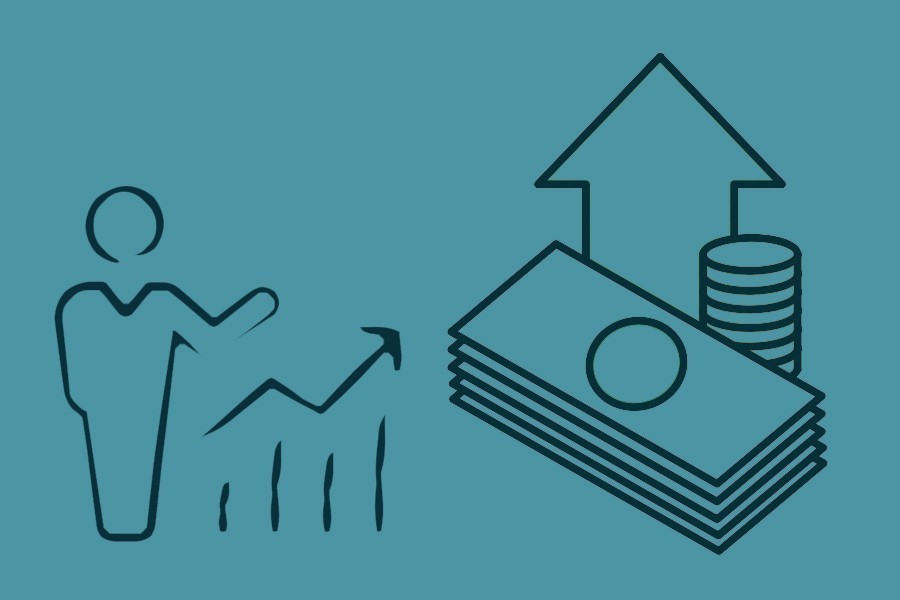Bangladesh is expected to join 7.0 per cent club in the 2020s as the country is experiencing a decade of strong and inclusive growth. Such club is an unofficial classification of the world's major economies with a nominal gross domestic product (GDP) of more than US$1.0 trillion per year.
With the tailwind of demographic dividend, healthy domestic consumption, rising investment, and successful export-oriented industrialisation, there are reasons to believe that Bangladesh will continue on this high-growth trajectory in coming days.
According to Standard Chartered India's projection, Bangladeshis will be richer than Indians by 2030 as the country's per capita income will grow nearly four times throughout the 2020s. The country's per capita income will rise to $5,734.6 in 2030. India's will edge up to $5,423.4 after growing less than three times, says the study.
The studye highlights the economies around the world that are likely to grow the fastest in the 2020s. The threshold for the list is 7.0 per cent, the approximate growth rate at which an economy can double in size every 10 years.
The study expects seven countries to do this in the 2020s: Bangladesh, India, Vietnam, the Philippines, Myanmar, Ethiopia and Ivory Coast. Of these, Bangladesh holds the most promise.
Young labour forces and accelerating structural reforms are, according to the study, likely to help Bangladesh achieve the desired growth in the coming decade. The country has seen its growth acceleration since 2010, to an average of 6.4 per cent, as a stable government, infrastructure investment and improved energy supply have boosted productivity gains.
The country posted more than 7.0 per cent GDP growth in the last three fiscal years and is estimated to go past the 8.0 per cent mark this fiscal year. Its demographic profile is favourable, and investments in education and health have paid off. All of this has helped improve productivity.
There is no denying that Bangladesh has become one of Asia's most remarkable and unexpected success stories in recent years. Once one of the poorest regions of Pakistan, Bangladesh remained an economic basket case-wreacked by poverty and famine-for many years after independence in 1971.
Analysts say Bangladesh's economic transformation was driven in large part by social changes, starting with the empowerment of women. Thanks to efforts by the nongovernmental organisations, along with more recent work by the government, Bangladesh has made significant strides toward educating girls and giving women a greater voice, both in the household and the public sphere.
These efforts have translated into improvements in children's health and education, such that Bangladeshis' average life expectancy is now 72 years, compared to 68 years for Indians and 66 years for Pakistanis. The government also deserves credit for supporting grassroots initiatives in economic inclusion, the positive effects of which are visible in recent data of the World Bank.
Another notable achievement for Bangladesh's progress is the success of its garment manufacturing industry. That success is itself driven by a number of factors. One notable point is that the main garment firms in Bangladesh are large-especially compared to those in India.
It was witnessed that many African countries lagged behind due to social and regional problems despite being on the path of development. In order to overcome such problems, there has to be more industrialisation in Bangladesh. Both production and jobs have to be increased. For this, more industries have to be set up and internal resources have to be increased.
Bangladesh has fulfilled the eligibility criteria set by the United Nations to be recognised as a developing country, crossing over from the list of least developed countries (LDCs).
Now it is a matter of time for the country to emerge from the LDC list to the list of developing countries. Per capita income of $1,230 is the minimum requirement for transitioning into a developing nation, and Bangladesh's income per capita currently stands at $1,274.
However, even if Bangladesh gets the recognition, the country has to seriously maintain the progress over the next 15 years. This will be a one-way process for Bangladesh. The country may not get back its previous title - even if it is a possibility - as countries which have over 75 million people cannot get the LDC title. Thus, Bangladesh has no scope for going back.
Recently, the International Monetary Fund (IMF) has predicted that the global economy will pace forward in 2018. Bangladesh will be able to take advantage of it if it makes adequate preparations. It needs to focus on improving the efficiency and productivity of the technologies.
Three million people are still living below the poverty line in Bangladesh. The economy is still not fully industrialised. In this context, along with the diversification of export products, the country has to move towards a production-oriented economy.
It should be remembered that the country's problems can't be solved merely through UN recognition. The government must focus on improving the business environment, ports and infrastructural development so that it can maintain right prices of goods in markets even if it does not get duty-free access.
As usual, when a country's economy takes off, corruption, cronyism, and inequality tend to increase, and can even stall the growth process if left unchecked. In case of Bangladesh, it is no exception. Inclusive development, good governance, and dispelling social discrimination are important to address the emerging situation.
The question is whether Bangladesh's strong economic performance can be sustained. As matters stand, the country's prospects are excellent, but there are risks that policymakers will need to take into account.


